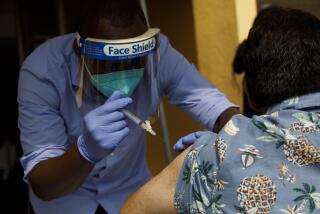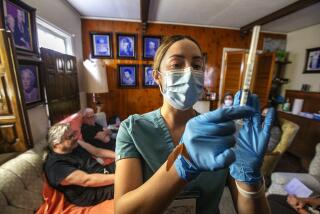Grass-roots groups are helping the homebound get vaccines. They’re racing against the clock

As vaccine access rapidly expands, some say vulnerable homebound people are being left behind.
- Share via
A quick jab, and the gates of freedom opened.
“You mean I can actually go out?” said Lillian “Lili” Shaw, not just a little awestruck, after getting the COVID-19 vaccine in the dining room of her Glendale home. “I’ve been stuck for a year in this prison.”
Frail from advanced age and severe arthritis, among other ailments, Shaw stayed shut up during the pandemic. A caregiver brought her groceries. Friends didn’t or couldn’t visit. She was scared to get the vaccine, and her daughter advised her not to because of her health problems. But waking up every day alone, “‘I’m going cuckoo,’” she told herself. “‘I have lost it.’”
When a local firefighter who visits Shaw regularly suggested she get vaccinated, she relented. She didn’t even have to go anywhere — they’d bring the dose to her.
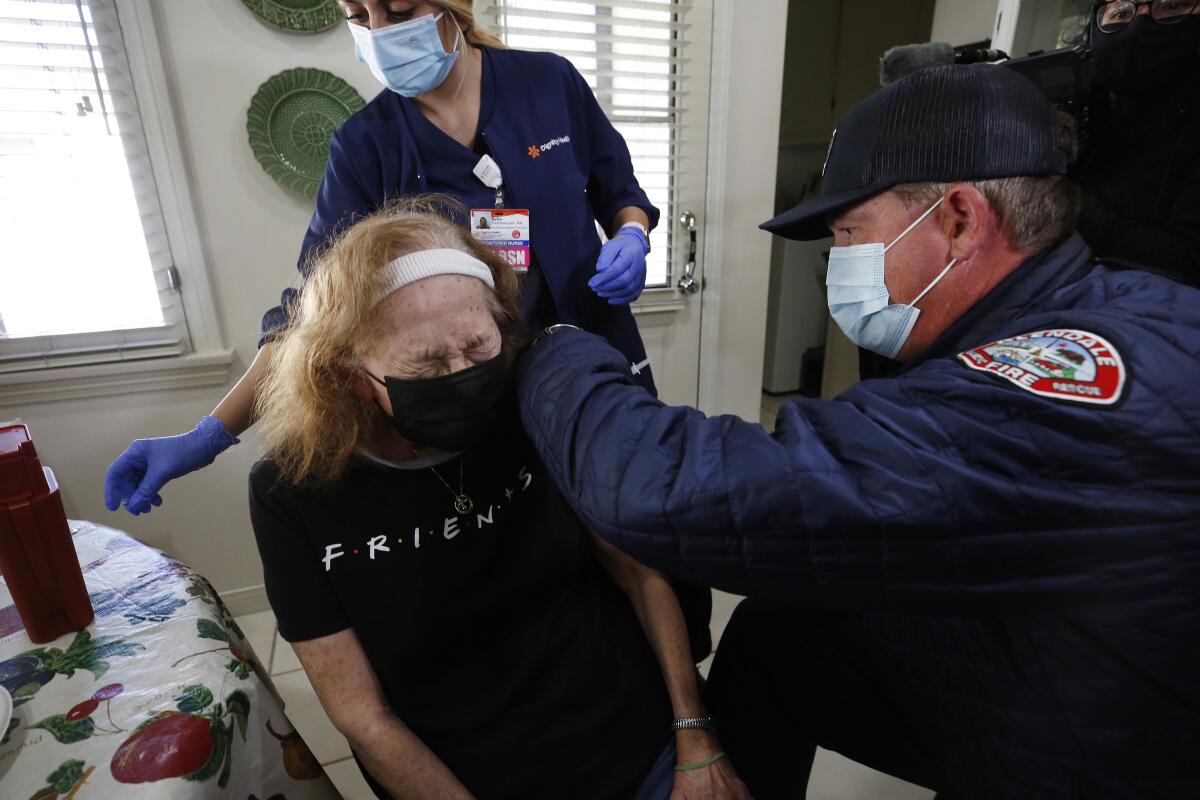
On Friday, the Glendale Fire Department and Glendale Memorial Hospital co-launched a pilot program to vaccinate homebound seniors living in the Jewel City. Shaw was one of the first to receive a dose.
The program is one of several grass-roots initiatives that have sprung up in recent weeks to bring shots to those too sick to leave home, a vulnerable population that some fear is being left behind even as vaccine access rapidly expands.
When vaccines started rolling out late last year, seniors and nursing home residents were among the first in line. Los Angeles County opened up access to those 65 and older in mid-January. But those who couldn’t leave the house easily — or at all — weren’t able to zip down to their doctor’s office or brave the daunting lines at Dodger Stadium.
That means many people like Shaw aren’t among the more than 70% of Californians over 65 who have received at least one vaccine dose, although they might be at the highest risk of dying from the virus.
Officials appear to be playing catch-up.
On March 23, the L.A. County Board of Supervisors unanimously voted to direct Los Angeles County’s Department of Public Health to come up with a strategy to reach the homebound, with a focus on seniors.
Supervisor Hilda Solis, who spearheaded the initiative, called them “an often silent and forgotten group.” About 2 million older adults across the U.S. are confined to their homes, often due to illness.
According to Solis, some 220,000 county residents receive in-home support services, and 55,000 homebound seniors receive daily meals delivered to their homes through Meals on Wheels and similar programs. “These represent only a portion of those who are homebound,” she added.
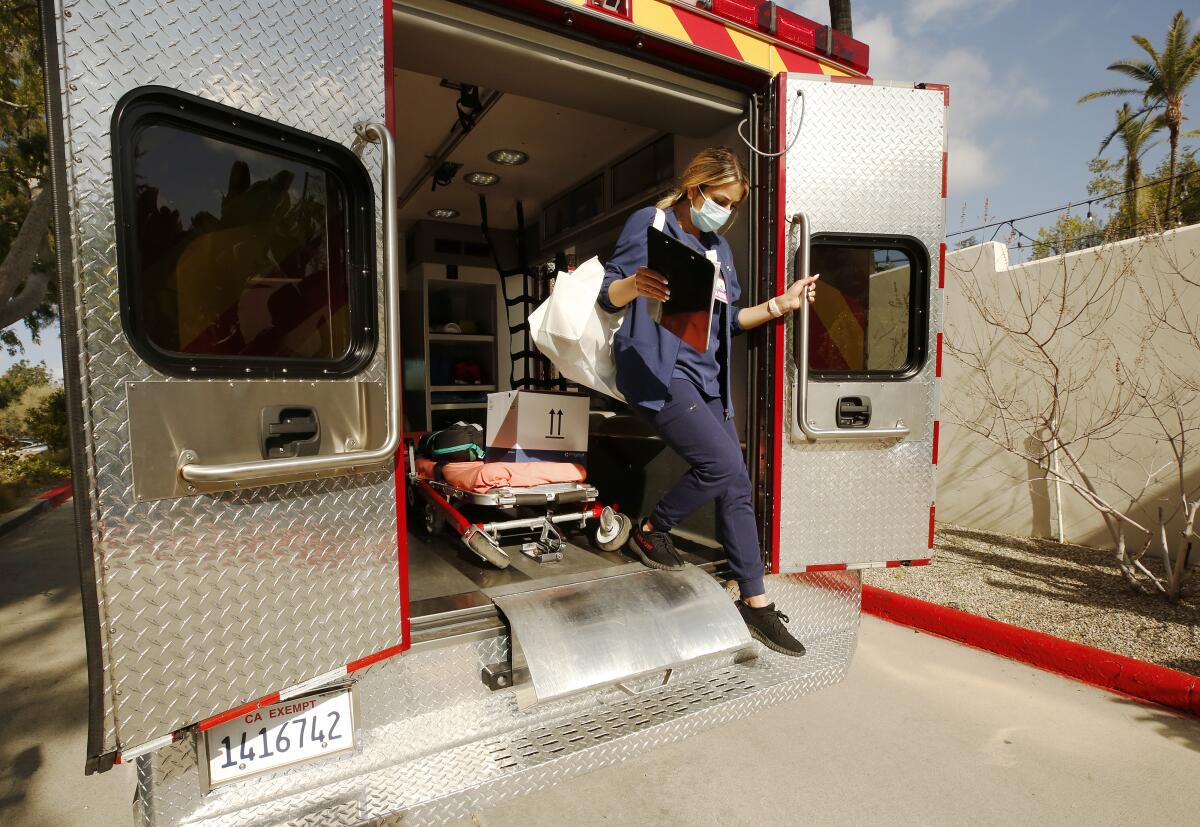
A day before the supervisors voted to pass the motion, county health officials said in an email that the department was working on a plan to vaccinate the homebound but declined to provide details.
Blue Shield, which won a state contract to help with the vaccine rollout, said through a spokesperson that the county’s plan could launch in early April and would include dispatching the Los Angles Fire Department and other emergency workers to people’s homes.
Many in the business of helping people — from hospitals to universities to public safety personnel — have stepped up to address the lingering disparity more quickly.
One week before the Glendale team set out, USC’s Keck School of Medicine launched a similar initiative targeting patients throughout Los Angeles County and beyond.
Keck geriatrician Dr. Laura Mosqueda, who heads the program, knew that many of her patients could not access the vaccine under the current system.
When the Johnson & Johnson vaccine became available, Mosqueda thought it was time to act; the single dose would make a logistically fraught process easier. Obstacles remain, however: Traffic is quickly bouncing back to levels only L.A. can serve up, and patients’ aggressive dogs don’t always welcome the medical teams. But the manifold benefits outweigh all that, she said.
“It’s wonderful, because people will be protected from dying of a horrible disease or becoming very, very ill from a horrible disease, but also for people now to be able to safely see family and friends is just huge,” she said. “We know that social isolation and loneliness is a huge risk factor for chronic illness with older adults.”

That was the case for Dorothy Rusch, who got a shot at her Pasadena home March 20, which happened to be her 101st birthday. Prone to bad cases of bronchitis, Rusch, who uses a wheelchair, hasn’t been able to see her friends at the local library or meet up with her women’s Chabad group for months.
Getting the vaccine, “did her heart good, it lifted her spirits,” her daughter Miriam Rusch said.
A team from UCLA Health began vaccinating patients in late January, several weeks before a single-dose option was available. It took the program a breakneck five days to get off the ground, from the first meeting to planning to execution, according to Dr. Sun Yoo, who is heading the effort. They tried to find a program to model their own on, but none seemed to exist.
On Thursday, Yoo and nurse practitioner Virginia Galan-Burns trekked to Barry Morrow’s Venice apartment, armed with a red cooler. Inside was a single dose of Moderna vaccine, ready to be administered. They’d circle back in a month to give him the second dose.
Morrow, 59, suffers from diabetes, sleep apnea and a host of other illnesses that limit his mobility. Every day a nurse stops by to wrap his swollen feet. When his primary care doctor said he wanted to have the UCLA team give him the vaccine, he said he had to check with his family first.
“They think it might help me,” he said. “Being a higher risk — you know, I’m not normal anymore.”
Morrow sat on a red motorized scooter, and Galan-Burns deftly jabbed his left arm. He said he didn’t feel anything and spent the 15-minute observation period joking and reminiscing about his younger, more agile days spent hanging out at the beach and playing sports.
Even as the homebound vaccination programs and tentative governmental progress are bringing an infusion of hope, some lament the length of time it’s taken to shine a light on the issue.
“Isn’t it sad that we are at the end of March, and this is being prioritized now, like three months after we’ve had vaccines?” asked Dr. Carla Perissinotto, associate chief for geriatrics clinical programs at UCSF. “Unfortunately, the process has been a little bit slow in terms of thinking about who’s the priority, and who doesn’t have a voice.”
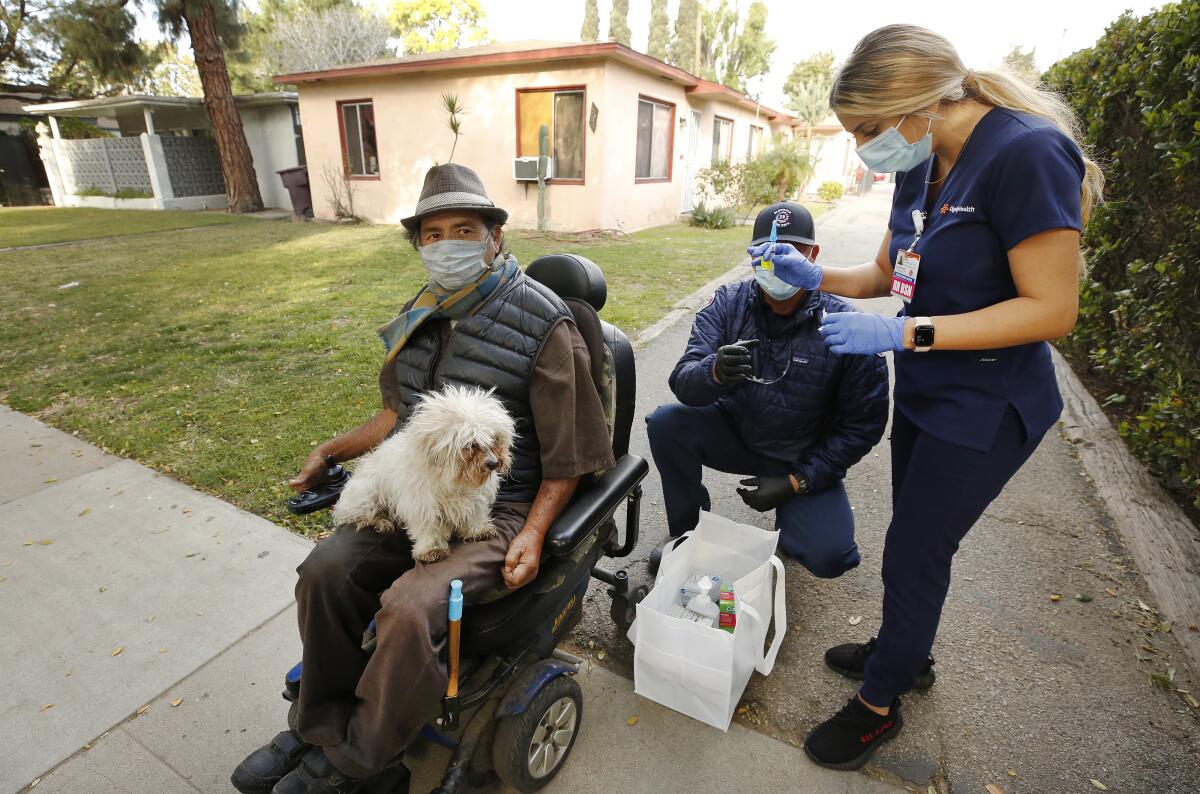
Perissinotto recently launched her own in-home vaccination program in the Bay Area. Initially lacking mobile refrigeration, she knew time was of the essence for her team to get shots into arms once a vaccine vial was cracked open. The Johnson & Johnson vaccine is stable at room temperature for two hours. In a place like San Francisco, precious time can be wasted circling the block looking for parking. Administering two doses took her two hours, she said.
“That is a huge amount of staff time and provider time,” she said.
All told, Perissinotto and her team vaccinated 40 people over three days, with 30 more the following week. USC’s program managed to inoculate 15 people in three days. Glendale Fire reached 15 people on its first day, with teams in three ambulances vaccinating five people each. UCLA’s initiative, which has been operating the longest, has given shots to around 140 people.
Contrasted with the thousands that can be vaccinated daily at mass sites, it’s a snail’s pace. Even with providers delivering at-home shots, it will likely take several months to approach vaccinating the majority of the homebound population. UCLA’s program has at least two more months on the clock, and other providers are still determining a timeline.
Vickie Mays, a professor of health policy and management at UCLA, said she believes ageism is one bias keeping the vaccines out of the vulnerable population’s arms, but it’s not the only one. Class, race and ethnicity may also limit homebound seniors’ access to vaccine, she added.
“If you have the money to put your loved one in a long-term care facility, well then, they got vaccinated very early in this process,” Mays said. “In communities of color in particular, there are individuals who can’t afford that.”
More to Read
Sign up for Essential California
The most important California stories and recommendations in your inbox every morning.
You may occasionally receive promotional content from the Los Angeles Times.


